Lest you should read the title of this journal and start picturing me on some fancy dinner cruise, or hunting whales on the open ocean, let me clarify a couple of things...
A) This is what night looks like in Antarctica.
 This was taken at 1:30am. Summer in Antarctica means there are 24 hours of daylight. The next sunset will be in February/March 2015!
This was taken at 1:30am. Summer in Antarctica means there are 24 hours of daylight. The next sunset will be in February/March 2015!
B) This is what sea looks like in Antarctica.
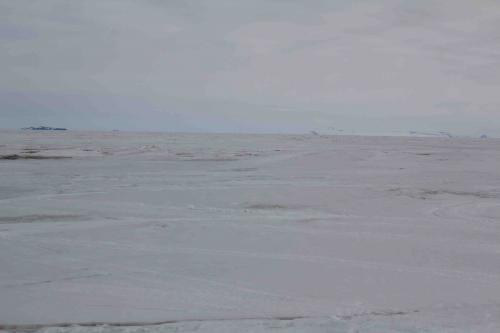 There is some open water, but it is much farther out.
There is some open water, but it is much farther out.
Regardless, I did get to spend a night out on the sea -- the sea ice, that is.
Meet Stacy Kim.
 Stacy gives me the skinny on project SCINI. Photo credit: Rachel Obbard.
Stacy gives me the skinny on project SCINI. Photo credit: Rachel Obbard.
Stacy is a friend of Rachel's and a benthic ecologist – a specialist who studies organisms and interactions on the sea floor. She is conducting a massive study on food chains in the Antarctic marine environments. This involves setting up camp and studying the animals that use the ocean and the sea ice as their home.
For part of the year, she is out scuba diving in the ocean to collect data. At another part of the year, she is out on the edge of the ice studying populations of killer whales and what they eat!
Right now, she is drilling holes in the sea ice to collect a lot of data about the krill and fish that feed right under it.
There is a lot going on, and, for one night, Rachel and I got to go out and be part of the team!
Here's how it all goes down
Stacy and her team ride an entourage of snowmobiles out to the pre-selected research site on the ice.
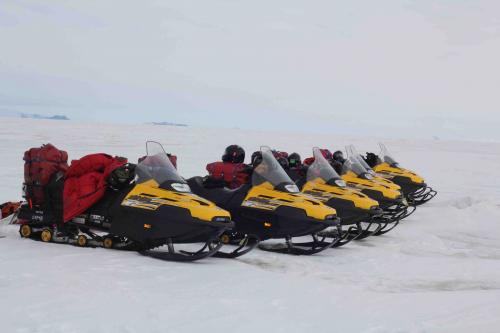 This night's site happened to be quite far away. In total, I put over 120 km on my snowmobile, round trip. Not bad for my 3rd ride ever!
This night's site happened to be quite far away. In total, I put over 120 km on my snowmobile, round trip. Not bad for my 3rd ride ever!
First they drill a small hole and place a flag in it.
 The flag marks the site, which they will return to in the next phase of research.
The flag marks the site, which they will return to in the next phase of research.
Next, they park their moving science shed right next to the flag.
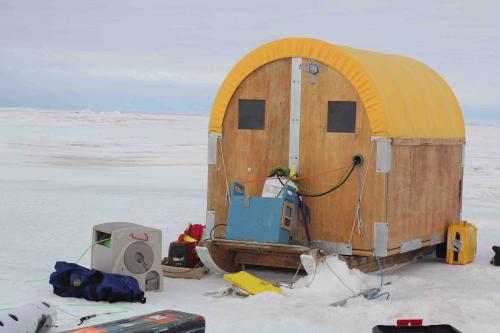 This shed is heated inside and carries all of the delicate science instruments, like robots, computers, and PlayStation parts. Maybe that is why it looks so happy.
This shed is heated inside and carries all of the delicate science instruments, like robots, computers, and PlayStation parts. Maybe that is why it looks so happy.
Using a very large drill, they make three large holes.
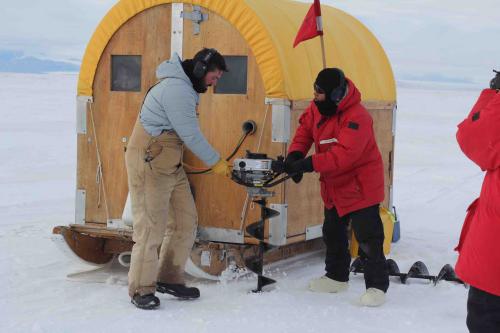 Phillip and Whit drill the first hole at this site. The drill is so large it requires two people to operate.
Phillip and Whit drill the first hole at this site. The drill is so large it requires two people to operate.
In one of those large holes, they set up a GPS device, which will keep track of their data-collecting underwater robots.
 The GPS is at the end of a 20-foot long metal T, and sends and receives signals from SCINI, the underwater ROV, to keep track of its position in the water.
The GPS is at the end of a 20-foot long metal T, and sends and receives signals from SCINI, the underwater ROV, to keep track of its position in the water.
In a second one of those large holes, they collect a sea ice core. The bottom part of the core has a rich variety of algae, which they take back to the lab to study more carefully.
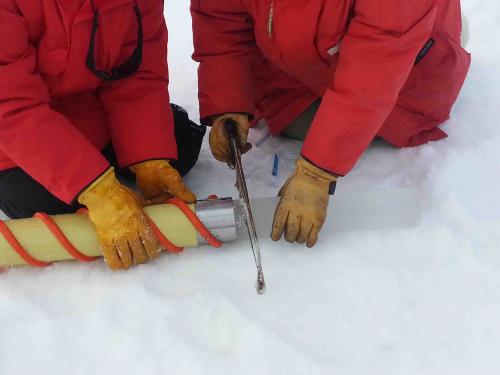 Stacy and Rachel saw off the top of an ice core that I drilled all by myself! The algae they need to study are only in the bottom part of the core.
Stacy and Rachel saw off the top of an ice core that I drilled all by myself! The algae they need to study are only in the bottom part of the core.
They also take measurements of the ice thickness in this hole and the snow depth for 100 feet around the hole.
In the third large drill hole, they first drop a gadget called a Niskin Bottle. This is like a big, spring-loaded thermos with openings at either end that can be tripped to close by a cable. They lower this device way into the ocean to collect samples of ocean water at specific depths, containing phytoplankton and chlorophyll. These, and the algae from the ice core, are primary producers in this food chain.
 The Niskin bottle collects 6 liters of sea water, which are taken back to the lab at McMurdo for analysis.
The Niskin bottle collects 6 liters of sea water, which are taken back to the lab at McMurdo for analysis.
Also in this hole, they lower a CTD instrument – Conductivity Temperature Depth – and collect these measurements from the ocean. This tells them the conditions of the ocean itself where they find the organisms that they study.
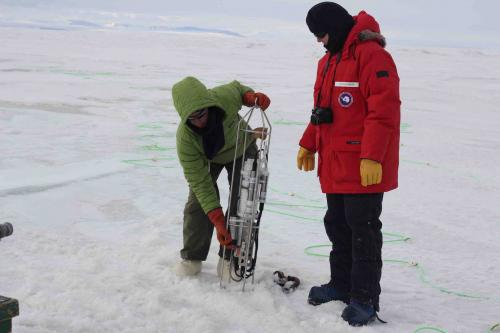 Conductivity is a proxy measurement for the salinity of the ocean, which, along with the temperature and the depth of the water, may influence which organisms live or feed there.
Conductivity is a proxy measurement for the salinity of the ocean, which, along with the temperature and the depth of the water, may influence which organisms live or feed there.
Finally, they lower Scini (pronounced 'Skinny') and Fatti (pronounced 'Fatty') into the hole, with 150m of tether.
SCINI stands for Submersible Capable of under Ice Navigation and Imaging, and is a remote controlled robot that Stacy's team designed to take pictures underwater. FATTI stands for Fluorometer and Acoustic Transducer Towable Instrument, and measures the fluorescence of the objects it passes. Since different organisms have different body densities, they return unique readings to the fluorometer, which helps the team identify how many and what types of organisms are active in the water.
 SCINI weighs about 40 lbs while FATTI weighs 100 lbs, so it takes several people to carefully lower them both into the water without tangling the 150m of tethering cables attached to them.
SCINI weighs about 40 lbs while FATTI weighs 100 lbs, so it takes several people to carefully lower them both into the water without tangling the 150m of tethering cables attached to them.
Then, from their warm science hut, two pilots use a PlayStation controller to 'drive' Scini and Fatti 150 meters in either direction, just underneath the sea ice surface. They then dive them down to the sea floor, and drive 150 meters along the floor in either direction. The whole way, SCINI is taking pictures of what it sees, while FATTI is collecting data about the organisms that it runs into.
 The pilots call it 'flying' the robots, because they are neutrally buoyant and feel light to manoeuveur.
The pilots call it 'flying' the robots, because they are neutrally buoyant and feel light to manoeuveur.
 And who said that videogames don't help you learn science?
And who said that videogames don't help you learn science?
All of this information is instantly transferred via copper wires in the tether directly to their computers.
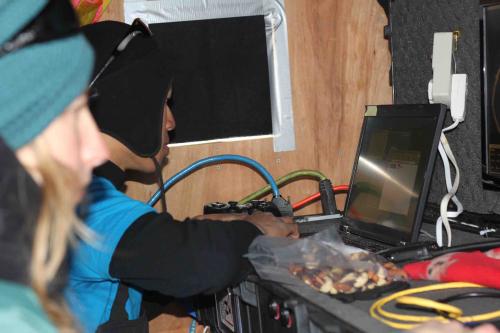 Graduate student, Dorota, captures the images and data coming in over the tether while Phillip flies SCINI beneath the Sea Ice surface.
Graduate student, Dorota, captures the images and data coming in over the tether while Phillip flies SCINI beneath the Sea Ice surface.
Wildlife encounters on land
While the robots are underwater, Stacy steps away from the camp to collect seal poo! Looking at scat samples (the more 'sciencey' way to say seal poo) can tell her what the seals are eating.
 Stacy documents a scat sample before collecting it.
Stacy documents a scat sample before collecting it.
Other teams that they partner with collect data from whales and penguins.
All together, all of this data, from the tiny algae and phytoplankton all the way up to the killer whales and seals, gives Stacy's team a complete picture of the entire food chain in the Antarctic marine ecosystem!
Even though it wasn't part of their data collection, we also decided to pay some emperor penguins a visit, just to make sure they were okay.
 Emperor penguins near a swimming hole. Most are sleeping, since it is night time. Some sleep on their bellies while others stand up and slouch their necks.
Emperor penguins near a swimming hole. Most are sleeping, since it is night time. Some sleep on their bellies while others stand up and slouch their necks.
When we got back, we found a single Adélie penguin had come to visit our camp! He decided to lie down and take a nap by my snowmobile for a while. We were happy to have him there, but soon his other penguin friends came to get him and take him home.
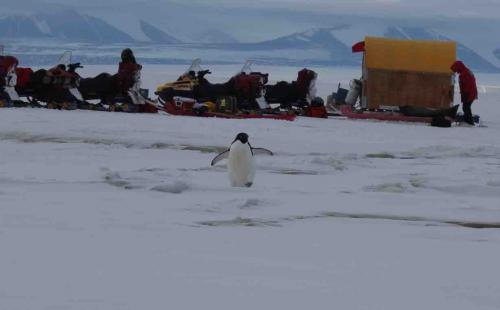 While we were visiting the Emperors, we saw this little one climb out of the swimming hole and go waddling in the direction of camp.
While we were visiting the Emperors, we saw this little one climb out of the swimming hole and go waddling in the direction of camp.
 He seemed a little uneasy and lonely on his own, but eventually settled in for a nap.
He seemed a little uneasy and lonely on his own, but eventually settled in for a nap.
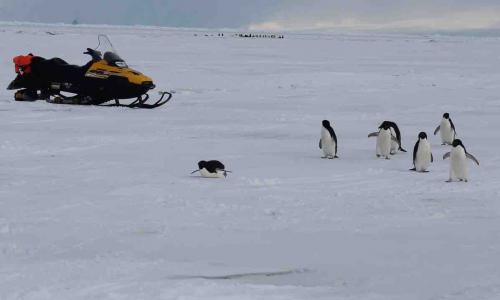 His friends arrive to fetch him and take him home.
His friends arrive to fetch him and take him home.

 He pauses for a moment, as if to say goodbye to the team...
He pauses for a moment, as if to say goodbye to the team...
 ...then takes off into the sun(set?) with his friends.
...then takes off into the sun(set?) with his friends.
By the time we had finished the collection at 2 sites, it was 3:30am! We packed up the gear on the sleds and snowmobiles, and headed back to camp. After unpacking and enjoying a warm cup of hot chocolate, it was time to get back home to McMurdo. By the time we arrived, it was 8am!
We were exhausted, and went right to bed, dreaming happy dreams of penguin reunions and seal poo!
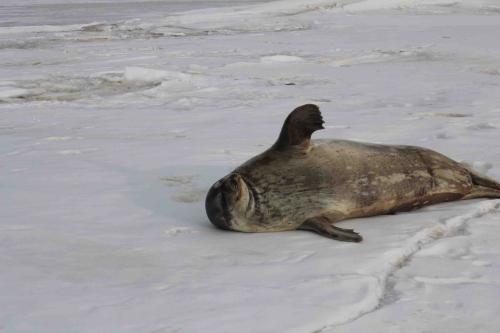 Bye guys! Thanks for a great night at sea!
Bye guys! Thanks for a great night at sea!

Comments